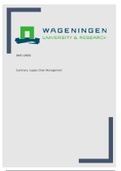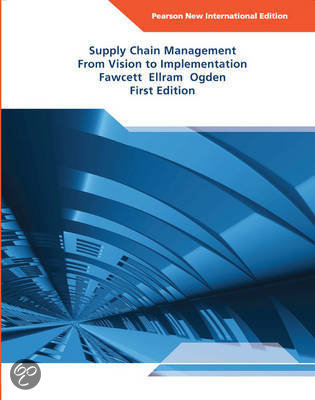BMO-24806
Summary: Supply Chain Management
1
,Chapter 1: Consumers demands towards the supply chain key
changing aspects:
o Higher quality, safety, convenience products
o Assortment and choice (have grown)
o Competitive pricing
o Availability of products (e.g. year round fresh products)
o Characteristics of production processes (animal welfare, child labour, environmental load)
o Innovation (products and processes. E.g. online sales)
• Business demands towards businesses and supply chains:
o Higher value added (via more processing the product e.g. packaging) → higher contribution
margins!! (whether the customer is likely to pay for it)
o Increasing product assortment (also to be competitive)
o More efficient product flows
o Global sourcing and development of partnerships and dealing with new policies and
legislation
o Quality and safety standards and systems and sustainable production processes (e.g. cradle
to cradle) (standards are key in globalization!!)
o Shorter product life cycles (and new market relationships)
• Companies search for supply chain collaboration: for the reason of:
o Companies seek to design their business models which enables them to meet customers
better than competitors (logical!) → by collaboration.
o Collaboration with other companies in the chain can support company’s success! (e.g. high-
quality producer needs high quality raw materials) → close collaboration.
• Requirements for SCM:
o A common understanding of supply chain objectives and individual roles
o An ability to work together
o A willingness to adapt in order to create and deliver the best products and service possible.
o SCM enables companies to focus on their unique skill sets → via combining all individual
skillsets → best possible products is generated! (logical)
▪ E.g. distribution, production, retail, etc.
• Definition of SCM:
o Supply chain management is the design and management of seamless (logistics), value-
added (production) processes across organizational boundaries to meet the real needs of the
end customer.
o The SCM manager should find opportunities to work with customers and suppliers to reduce
the cost while improving service.
• Porters model
o Lower half: are the value-added aspects within SCM
2
,o Upper half: are the support aspects that support the primary process of the value-adding processes!
(logical)
o Primary focus has to be held on the primary processes due to the fact that these will focus on the
value-adding processes!! (also called: lean management)
o Every company within a SCM has its own supply chain (logical!)
• Focus of SCM is mostly derived from the focal firm perspective:
o Is the analysis of a supply chain through the perspective of the focal company. (it is not
necessary that the company is actively involved. Can also be a ‘mother company’) → but is
the company from which the supply chain is analysed.
o The management of companies of often more applicable for upstream focus
o Monitoring is almost always done on downstream focus. (upstream is both managing and
monitoring)
Relationship companies are shown in columns and called ‘tiers’.
• Focus of SCM can also be derived from a network perspective:
o In analysis not only the own firm efficiencies but ALSO makes different potential supply
chains comparable with each other.
3
, o E.g.
• Focus of SCM can also be derived from a Macro perspective:
o Based on different classifications:
▪ A system (domestic): low market income (high volume, low value → low
contribution per product per unit within the supply chain)
▪ B system (domestic, market): medium-high market income (around equal volume
value →realised with more contribution (value addind) per product.
▪ C system (export): high marker → lower volumes with high value (realised via high
value adding capacity throughout the supply chain)
4
,• Supply chain collaboration: different levels of intensity:
o Types of integration: differs per firm (least common is fully integrated supply chain)
o Internal value chain elements (Primary processes related → Porters model):
▪ Executive Management defines company strategy and allocates resources to
achieve it.
▪ Supply Management coordinates the upstream supply base, finding the right
suppliers and building the right relationships with them.
▪ Operations transforms the inputs acquired from suppliers into more highly valued
products.
▪ Logistics moves and stores materials, so they are available when and where they are
needed.
▪ Marketing manages the downstream relationships with customers, identifying their
needs and communicating to them how the company can meet those needs.
o Internal value chain elements (Support processes related → Porters model)
▪ Human Resources designs the systems used to hire, train, and develop the
company’s employees.
▪ Accounting maintains business records that provide information needed to control
operations.
▪ Finance acquires and controls the capital required to operate the business.
▪ Information Technology builds and maintains the systems needed to capture and
communicate information among decision makers.
▪ Research and Development (R&D) is responsible for new product design.
o Each aspect of the internal chain elements are applied separately → local focus
5
, o Each aspects of the internal chain elements are applied while considering the effect and
relation of each other → company focus
▪ A supply chain consists of a series of linked value chains.
▪ Interaction between different business units within a company is key! E.g. when
supply manager purchases large quantities without informing the logistic/inventory
manager. This could lead to problems in inventory/logistical management
(therefore close collaboration is key in acting most efficient)
• 4 types of supply chain integrations:
1. Internal process integrations: goal is to increase collaboration among the company’s
functional groups (logical!)
2. Backward process integration with valued first-tier suppliers: leading companies are
integrating their suppliers (also common that lead companies integrate another step
backwards → integrating suppliers of suppliers.)
3. Forward process integration with valued first-tier customers: only few companies have
this. (key customers)
4. Complete forward and backward integration from the ‘suppliers’ supplier to the
customers’s customer. (full integration of the supply chain)
6
,• Advantages of supply chain collaboration:
o Increased customer responsiveness
o Shorter order fulfilment lead times and reduced inventory costs
o Reduced transaction costs
o More grip on quality, safety and sustainability of products
o Branding
o Faster (joint) innovation → combining knowledge, expertise, and skills
• Supply chain strategy:
o The objective of companies is to increase the profit of the company and therefore generate
wealth of the shareholders. The best, and most logical, way of doing this is to focus on
satisfying the customer
o The strategy is the basis from which a consistent allocation of resources is made to achieve
the objective.
• Strategic Thinking Traditional View
o A valid business model must answer two questions:
1. What is our business?
▪ Who are our customers?
▪ What is the real value that we offer them?
2. How can we do it better than anyone else?
▪ Via Unique resources
▪ Via Unique organizational capabilities
• Supply Chain Strategy
o Seeks to leverage the resources and capabilities of diverse companies in the supply chain
to deliver value to the end customer.
o Addresses:
▪ How the capabilities of other chain members can be used to create value for the
end customer (other companies unique factors)
▪ How their own strategy and actions impact the ability of the supply chain to create
value for the end customer (own strategy contributing to value creation via applying
companies’ unique factors)
▪ Are any customer-valued competencies missing? If so, who is best positioned to
develop them?
• Strategic management theories:
o Contingency theory: shows the relationship between changing environment and decision
making → changes have to be recognziced after which managerial decisions have to be
altered.
o Industrial organization theory: claims that market forces should drive decision making → via
the use of the Michael Porter model (suppliers, buyers, existing rivals, potential rivals,
providers substiture product) a company can assess their position in the market and
therefore their market power (logical!!)
o Resource-based theory: emphasizes the management of internal resources to establish a
hard-to-imitate advantage (use of core competencies) → focusses on building organizational
skills and processes that enable a company to deliver a unique product
• SCM and four decision areas of Strategy
o Objectives: help the supply chain satisfy end- customer needs (key to generate wealth) →
customer satisfaction, profitability will follow.
o Resources: develop unique capabilities, develop and manage supplier capabilities (use of
core competencies)
o Environment: respond to changes in competitive environment
o Feedback: measure and continuously improve supply chain performance
7
, Summary book:
• The Theory of SCM:
o Goal scm: is to meet customer needs better than competitors
o Goal scm: to build a corporate team consisting of suppliers, finished goods producers, service
providers, and/or retailers.
o Success depends on building processes that can design, make, and deliver the innovative,
high-quality, low-cost products and services that customers demand.
o Use resources of suppliers and customers can be used to create value. The effort to align
goals, share resources, and collaborate across company boundaries is the essence of SCM.
o Scm allows companies to do a few things very well for which it has unique skills
o Other activities are outsourced to companies that have that specific unique skill to add value
to the product.
• Problems:
o Bullwhip effect: the demand variations are likely to be exaggerated as decisions are made up
the chain. Increases in demand begin at the retail level. To fulfil expected future orders, the
retailer places a larger order with its distributors. Not wanting to run out of stock, the
distributor places an even larger order with the upstream manufacturer. The supplier will
therefore order more stock to maintain inventory levels. When demand drops. The suppliers
will face with significant inventory holding costs!.
8





